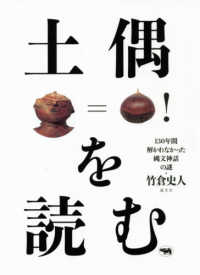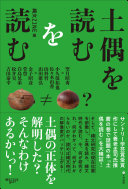
『土偶を読む』批判が齎したもの
Critique of "How to read Japanese ancient
clay figurines"

☆ 竹倉史人『土偶を読む』の人口への膾炙に警鐘をならす望月昭秀は、現在の日本社会の「専門知」が市井の人たちに支持されていないことへの警鐘の兆候を読み込んでいる。
 2021年に刊行されるやいなや、NHKをは
じめとするメディアや著名識者が絶賛、ベストセラーとなり、サントリー学芸賞を受賞した『土偶を読む』(竹倉史人著、晶文社)。土偶は人ではなく、植物を
モチーフにしている、という新説を提示したこの本は、土偶解釈の大胆さやユニークさとともに、専門家や専門知に果敢に挑戦したことが高い評価につながっ
た。考古学の専門家ではない竹倉氏が、考古学の権威と闘うというストーリーが、識者や読者の共感を得たのだ。 2021年に刊行されるやいなや、NHKをは
じめとするメディアや著名識者が絶賛、ベストセラーとなり、サントリー学芸賞を受賞した『土偶を読む』(竹倉史人著、晶文社)。土偶は人ではなく、植物を
モチーフにしている、という新説を提示したこの本は、土偶解釈の大胆さやユニークさとともに、専門家や専門知に果敢に挑戦したことが高い評価につながっ
た。考古学の専門家ではない竹倉氏が、考古学の権威と闘うというストーリーが、識者や読者の共感を得たのだ。この本へのいわば“アンサー本”が、今年、専門家の立場から出た。縄文時代をテーマにした雑誌『縄文ZINE』の編集人・望月昭秀氏と9人の考古学研究者 らによる『土偶を読むを読む』(文学通信)である。望月氏らは、竹倉説が「皆目見当違い」であることを最新の研究に基づいて論証したうえで、自由な発想は 歓迎すべきものだが、専門知には専門知の役割があることを示す。 https://jbpress.ismedia.jp/articles/-/76471 |
 As soon as it was published in 2021, “Reading Dogu (clay
figures)” (written by Fumito Takekura, published by Shobunsha) received
rave reviews from the media and prominent intellectuals, including NHK,
and became a bestseller, winning the Suntory Prize for Arts and
Sciences. The book, which presented a new theory that clay figurines
were based on the motif of plants rather than people, was highly
acclaimed not only for its bold and unique interpretation of clay
figurines, but also for its bold challenge to experts and specialized
knowledge. The story of Takekura, who is not an archaeologist, fighting
against the authority of archaeology won the sympathy of experts and
readers alike. As soon as it was published in 2021, “Reading Dogu (clay
figures)” (written by Fumito Takekura, published by Shobunsha) received
rave reviews from the media and prominent intellectuals, including NHK,
and became a bestseller, winning the Suntory Prize for Arts and
Sciences. The book, which presented a new theory that clay figurines
were based on the motif of plants rather than people, was highly
acclaimed not only for its bold and unique interpretation of clay
figurines, but also for its bold challenge to experts and specialized
knowledge. The story of Takekura, who is not an archaeologist, fighting
against the authority of archaeology won the sympathy of experts and
readers alike.This year, an “answer book,” so to speak, to this book was published from the standpoint of a specialist. The book is titled “Reading Dogu” (Bungaku Tsushin), written by Akihide Mochizuki, editor of Jomon Zine, a magazine on the Jomon period, and nine archaeological researchers. Mochizuki and his colleagues argue, based on the latest research, that the Takekura theory is “all wrong,” and then show that, while free thinking is welcome, specialized knowledge has a role to play. |
| 批判対象になっている人:「佐伯順子」 この新説を疑問視する「専門家」もいるかもしれない。しかし、「専門家」という鎧をまとった人々のいうことは時にあてにならず、「これは〇〇学ではない」 と批判する“研究者”ほど、その「○○学」さえ怪しいのが相場である。「専門知」への挑戦も、本書の問題提起の中核をなしている。 https://jbpress.ismedia.jp/articles/-/76471 |
Prof. Jyunko SAEKI "Some “experts” may question this new theory. However, it is sometimes difficult to rely on those who wear the armor of “experts,” and even their “xxxology” is more dubious than that of “researchers” who criticize “this is not xxxology. The challenge to “specialized knowledge” is also at the core of the issues raised in this book." |
| 批判 望月 竹倉さんの新説については、僕の知る限り、疑問視する専門家しかいない状態です。その理由はこの本(『土偶を読むを読む』)に書いた通りです。だか らこの言葉を聞いて、専門家は怒らないといけないと思いました。僕は、いわゆる専門家という立場ではありませんが、長年縄文に関わってきた人間として、 「えーっ!考古学めちゃめちゃ言われてるじゃん!」と思いましたね。 ──『土偶を読む』に対して、なぜ研究者などの専門家がすぐに批判しなかったと思われますか? 望月 まず、そもそも『土偶を読む』が一般書というジャンルから出ていて、学術という俎上に上がってこなかったことが大きかった。しかしそれ以上に検証し たり批判したりするには相応の時間とカロリーを消費します。専門家だって忙しく、自分の仕事をしながら検証するのは大変だという状況があります。それか ら、たくさん出てくるトンデモ説を一つひとつ検証していてもキリがない、という理由もあると思います。 |
Mochizuki : As far as I know,
there are only experts who question Takekura's new theory. The reason
for this is as I wrote in this book (“Reading the Clay Figure”). So
when I heard these words, I thought that experts must be angry. I am
not what you would call an expert, but as someone who has been involved
with the Jomon for many years, I thought to myself, “What? Archaeology
is being called a mess! I thought. ─ ─ Why do you think researchers and other experts did not immediately criticize “Reading Clay Figures”? Mochizuki: First of all, it was significant that “Reading Dogu” was written in the genre of general books, and was not discussed at the academic level. But more than that, it consumes a reasonable amount of time and calories to verify and criticize. Even experts are busy, and it is difficult for them to verify the information while doing their own work. Another reason is that there is no end to the number of theories that can be tested one by one. |
 『土偶を読む』とはどんな本か? 『土偶を読む』とはどんな本か?内容説明 縄文時代に大量に造られた素焼きのフィギュア=「土偶」。謎めいたその姿をめぐって、土偶の研究は明治、大正、昭和、平成、令和と130年以上にわたって 繰り広げられてきた。その「正体」については「妊娠女性説」や「地母神説」などがあるが、いずれも確証が得られておらず、縄文土偶はいまだに詳細不明の遺 物となっている。本書では、土偶の形態を具体的に分析するイコノロジー研究の手法と、環境文化史・民族植物学を含む最新の考古研究の実証データを用いるこ とで、ついに土偶の「真実」を明らかにする。 目次 第1章 土偶プロファイリング1 ハート形土偶 第2章 土偶プロファイリング2 合掌土偶・中空土偶 第3章 土偶プロファイリング3 椎塚土偶(山形土偶) 第4章 土偶プロファイリング4 みみずく土偶 第5章 土偶プロファイリング5 星形土偶 第6章 土偶プロファイリング6 縄文のビーナス(カモメライン土偶) 第7章 土偶プロファイリング7 結髪土偶 第8章 土偶プロファイリング8 刺突文土偶 第9章 土偶プロファイリング9 遮光器土偶 第10章 土偶の解読を終えて 著者等紹介 竹倉史人[タケクラフミト] 人類学者。独立研究者として大学講師の他、講演や執筆活動などを行う。武蔵野美術大学映像学科を中退後、東京大学文学部宗教学・宗教史学科卒業。2019 年、東京工業大学大学院社会理工学研究科価値システム専攻博士課程満期退学。人類の普遍的心性を探求すべく世界各地の神話や儀礼を渉猟する過程で、縄文土 偶の研究に着手することになった(本データはこの書籍が刊行された当時に掲載されていたものです) ※書籍に掲載されている著者及び編者、訳者、監修者、イラストレーターなどの紹介情報です。 https://www.kinokuniya.co.jp/f/dsg-01-9784794972613 |
|
| 土
偶を読むを読む / 望月昭秀編 ; 金子昭彦 [ほか] 執筆, 第2版. - 東京 : 文学通信 , 2023 考 古学の実証研究とイコノロジー研究を用いて、土偶は「植物」の姿をかたどった植物像という説を打ち出した本書は、NHKの朝の番組で大きく取り上げられ、 養老孟司ほか、各界の著名人たちから絶賛の声が次々にあがり、ついに学術書を対象にした第43回サントリー学芸賞をも受賞。 「『専門家』という鎧をまとった人々のいうことは時にあてにならず、『これは〇〇学ではない』と批判する“研究者”ほど、その『○○学』さえ怪しいのが相 場である。『専門知』への挑戦も、本書の問題提起の中核をなしている」(佐伯順子)と評された。 しかし、このような世間一般の評価と対照的に、『土偶を読む』は考古学界ではほとんど評価されていない。それは何故なのか。その理由と、『土偶を読む』で 主張される「土偶の正体」、それに至る論証をていねいに検証する。 考古学の研究者たちは、今、何を研究し、何がわかって、何がわからないのか。専門家の役割とは一体なんなのか、専門知とはどこにあるのか。『土偶を読む』 を検証・批判することで、さまざまな問題が見えてくる。本書は、縄文研究の現在位置を俯瞰し、土偶を読み、縄文時代を読む書でもある。 執筆は、望月昭秀、金子昭彦、小久保拓也、佐々木由香、菅豊、白鳥兄弟、松井実、山科哲、山田康弘、吉田泰幸(順不同)。 【『土偶を読む』の検証は、たとえれば雪かきに近い作業だ。本書を読み終える頃には少しだけその道が歩きやすくなっていることを願う。雪かきは重労働だ。 しかし誰かがやらねばならない。(望月昭秀)...はじめにより】 |
|
| 望月昭秀の竹倉批判は、その背景にある佐伯順子の「評」のなかにある、現在の社会の通奏低音である「専門知への不審感」にある。また、それは、311以降にこの社会のなかにある、原子力や最近ではコロナ疫学の専門家への批判の一般化であるように思われる。 | Akihide
Mochizuki's criticism of Takekura lies in the background of Junko
Saeki's “review,” in which she expresses a sense of “suspiciousness
toward specialized knowledge,” which is a common tone in today's
society. It also seems to be a generalization of the criticism of
experts in nuclear power and, more recently, in coronary epidemiology,
which has existed in this society since 311. |
| 専門的な知識と技能: 専門的背景(法律、会計、産業、金融、マーケティング、技術など)、専門的スキル、業界経験。 専門的な知識と理解2.1 すべての学習者が潜在能力を発揮できるような機会を提供するために、どのように学習をパーソナライズするか を含め、さまざまな教授法、学習法、行動管理法を用い、適応させるかについて幅広い知識と理解を持つ。 プロセス 専門知識 専門技能 中核技能 責任 25. 貿易技術(専門技能と専門知識)、トレーニング方法論、エンジニアリング技術/ソフトスキルから構成される。 専門的知識と理解 2.1 すべての学習者が潜在能力を発揮する機会を提供するために、学習を個別化する方法を含め、さまざまな教育、学習、行動管理戦略をどのように使用し、適応させるかについて幅広い知識と理解を持つ。 この5つの領域とは、(1)プロセス、(2)専門知識、(3)専門スキル、(4)コア・スキル、(5)責任である。 専門的知識と技能 専門的背景(法律、会計、産業、金融、マーケティング、テクノロジーなど)、専門的スキル、業界経験。 専門的知識:分析・報告を含む上記分野における 3 年以上の実務経験、第三国での経験(大使館、国際機関、NGO 等)、EU 機関関連の意思決定プロセス、CFSP-CSDP、JLS、EU の対外行動および関連する EU の対外政策(地理的・テーマ別)に関する知識・経験。 専門的知識と理解 2.1. すべての学習者が潜在能力を発揮できるような機会を提供するための個別学習の方法を含め、様々な教授法、学習法、行動管理法をどのように用い、適応させるかについて幅広い知識と理解を持つ。 専門的な知識と技能:専門的な経歴(法律、会計、産業、金融、マーケティング、技術など)、専門的技能、業界経験を有する。 |
Professional
knowledge and skills: A professional background (e.g., law, accounting,
industry, finance, marketing, technology), professional skills, and
industry experience. Professional knowledge and understanding2.1 Have an extensive knowledge and understanding of how to use and adapt a range of teaching, learning and behaviour management strategies, including how to personalise learning to provide opportunities for all learners to achieve their potential. Process Professional knowledge Professional skill Core skill Responsibility 25. It consists of Trade Technology (Professional skills and Professional knowledge), Training Methodology and Engineering Technology/ Soft skills. Professional knowledge and understanding 2.1 Have an extensive knowledge and understanding of how to use and adapt a range of teaching, learning and behaviour management strategies, including how to personalise learning to provide opportunities for all learners to achieve their potential. These five domains are (1) Process, (2) Professional knowledge, (3) Professional skill, (4) core skill, and(5) Responsibility. Professional knowledge and skills: A professional background (e.g., law, accounting, industry, finance, marketing, and technology), professional skills, and industry experience. Professional knowledge - Have a professional experience of at least 3 years in the abovementioned areas, including analysis and reporting; experience in third countries (embassy, international organization, NGO, etc.); knowledge/experience of EU institutions related decision-making processes, CFSP-CSDP, JLS, EU external action and related EU external policies (geographical and thematic). Professional knowledge and understanding 2.1. Have an extensive knowledge and understanding of how to use and adapt a range of teaching, learning and behaviour management strategies, including how to personalise learning to provide opportunities for all learners to achieve their potential. Professional knowledge and skills:A professional background (e.g., law, accounting, industry, finance, marketing, technology), professional skills, and industry experience. https://www.lawinsider.com/dictionary/professional-knowledge |
リ ンク
文 献
そ の他の情報
Copyleft, CC, Mitzub'ixi Quq Chi'j, 1996-2099
☆
 ☆
☆